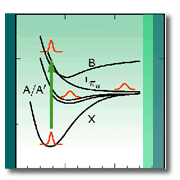 |
||||||||

Cinética y Fotoquímica
QUIMICA DE COORDINACION: FOTOSENSIBILIZADORES, SENSORES Y FOTOCATALIZADORES
Se investigan las propiedades fotoquímicas y fototofísicas de noveles compuestos de coordinación.
La investigación se centra principalmente en obtener conocimiento básico en el mecanismo de las reacciones redox iniciadas fotoquímicamente de compuestos de metales de transición libres y/o en sistemas supramoleculares.
En la mayoría de los casos, estos procesos generan compuestos en estados excitados o complejos con iones metálicos en estados de oxidación metaestables.
La información obtenida es aplicada al diseño de nuevos compuestos con propiedades ópticas predeterminadas.
Nuestro objetivo general es preparar y estudiar polímeros y/o macromoléculas que puedan funcionar como centros reactivos.
En estos centros reactivos supramoleculares la etapa fotoquímica primaria produce una separación de cargas. Estos centros reactivos pueden activar una catálisis, o pueden utilizarse como intermediarios en un mecanismo más complejo de reacción que involucre alguna especie exterior a la macromolécula que pueda ser usada como reductor de sacrificio.
Por otra parte, los centros reactivos pueden involucrar estados excitados que eventualmente puedan ser utilizados en reacciones de transferencia de energía o electrones.
Nos abocaremos al estudio de reacciones químicas de complejos y polímeros inorgánicos que produzcan intermediarios ricos en energía de importancia práctica.
Otro de nuestros objetivos es desarrollar nuevos complejos capaces de interactuar con moleculas de interés biológico como ácidos
nucleicos y proteínas.
Coordinador
Dr. Mario R. Féliz
Colaboradores
Ezequiel Wolcan, Gustavo Ruiz
Fabricio Ragone, Héctor H. Martinez Saavedra
Principales publicaciones del grupo referidas al
proyecto
(2007 - 2011)
* “On the mechanism of Re(I)-carboxylate bond cleavage by perchloric acid: A kinetic and spectroscopic study.”
U.N. Fagioli, F.S. García Einschlag, C.J. Cobos, G.T. Ruiz, M.R. Féliz y E. Wolcan
Journal of Physical Chemistry A , 115 (40), 10979-10987 (2011).
* “On the mechanism of formation and spectral properties of radical anions generated by the reduction of -[ReI(CO)3(5-nitro-1,10- phenanthroline)]+ and -[ReI(CO)3(3,4,7,8- tetramethyl-1,10-phenanthroline)]+ pendants in poly-4-vinylpyridine polymers.”
L.L.B. Bracco, R.O. Lezna, J. Muñoz-Zuñiga, G.T. Ruiz, M.R. Féliz, G.J. Ferraudi, F.S. García Einschlag y E. Wolcan
Inorganica Chimica Acta, 370 (1), 482-491 (2011).
* “Morphology and radical reactions of Cu(II) and Co(II) sulfonated phthalocyanines covalently linked to poly(ethyleneamide).
Contributions from the formation of nanometric, water-soluble, bundles to the phthalocyanine pendants′ reactivity.”
G.T. Ruiz, A.G. Lappin y G. Ferraudi
Porphyrins and Phthalocyanines, 14, 69-80 (2010).
* “On the elusive, non-emissive yet reactive, upper excited states of (4,4′-bpy)ReI(CO)3(dppz) PF6 (dppz = dipyridil 3,2-a:2′3′-c phenazine).”
G.T. Ruiz, G. Ferraudi, E. Wolcan y M. Féliz
Inorganica Chimica Acta, 363 (7), 1615-1618 (2010).
* “On the quenching of MLCT luminescence by amines: The effect of nanoaggregation in the decrease of the reorganization energy.”
L.L.B. Bracco, M.R. Féliz y E. Wolcan
Journal of Photochemistry and Photobiology A: Chemistry, 210 (1), 23-30 (2010).
* “Excited state vs. photoinduced charge separation in bundles of a polyamide containing pendent Al(III) phthalocyaninetetrasulfonate groups.
Potential applications to photocatalysis.”
G.T. Ruiz, G. Ferraudi y A.G. Lappin
Journal of Photochemistry and Photobiology A: Chem., 206, 1-9 (2009).
* “On the nature of the redox products of 4-((CH3)2N)C6H4-CO2- and 4-((CH3)2N)C6H4-CO2-Re(CO)3(1,10-phenanthroline): a spectroelectrochemical, pulse radiolysis and flash photochemical study .”
M.P. Juliarena, R.O. Lezna, G.T. Ruiz, M.R. Feliz, G.I. Ferraudi y E. Wolcan
Polyhedron, 27, 1471-1478 (2008).
* “Inhibition of the fac-(RCO2)Re(I)(CO3)(bis-azine) photodecarboxilation of the carboxylate ligand,
RCO2-, when R is a strong electron donating group. The thermal and photochemical properties of complexes where R = ferrocene- and
4-(N,N-dimethylamino)benzyl.”
M.P. Juliarena, G.T. Ruiz, E. Wolcan, R.O. Lezna, M.R. Féliz y G. Ferraudi
Organometallics, 26, 272-280 (2007).
* “Kinetic and spectroscopic observations on the azidyl radical oxidation of fac-(Lspec)Re(I)(CO3)(Lacep) to fac-(Lspect)Re(II)(CO)3(Lacep).”
G.T. Ruiz, M.P. Juliarena, E. Wolcan y G. Ferraudi
Inorganica Chimica Acta, 360, 3681-3687 (2007).
* “Intercalation of fac-[(4-4' bpyRe(CO3)(dppz)+, dppz = dipyridil[3,2-a:2' 3'-c]phenazine, en polynucleotides. On the UV-vis phoophysics of the Re(I) intercalate and the redox reactions with pulse radiolysis-generated radicals.”
G.T. Ruiz, M.P. Juliarena, R.O. Lezna, E. Wolcan, M.R. Féliz y G. Ferraudi
Journal of Chemical Society. Dalton Transaction, 20, 2020-2029 (2007).